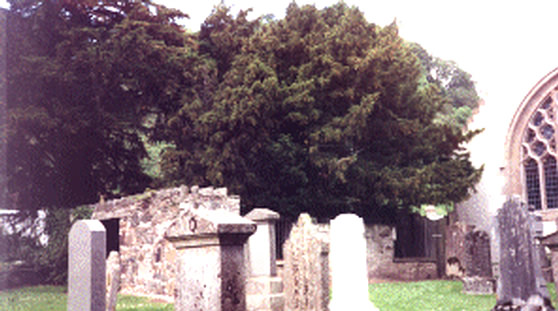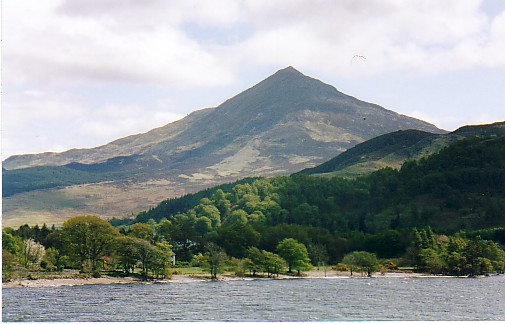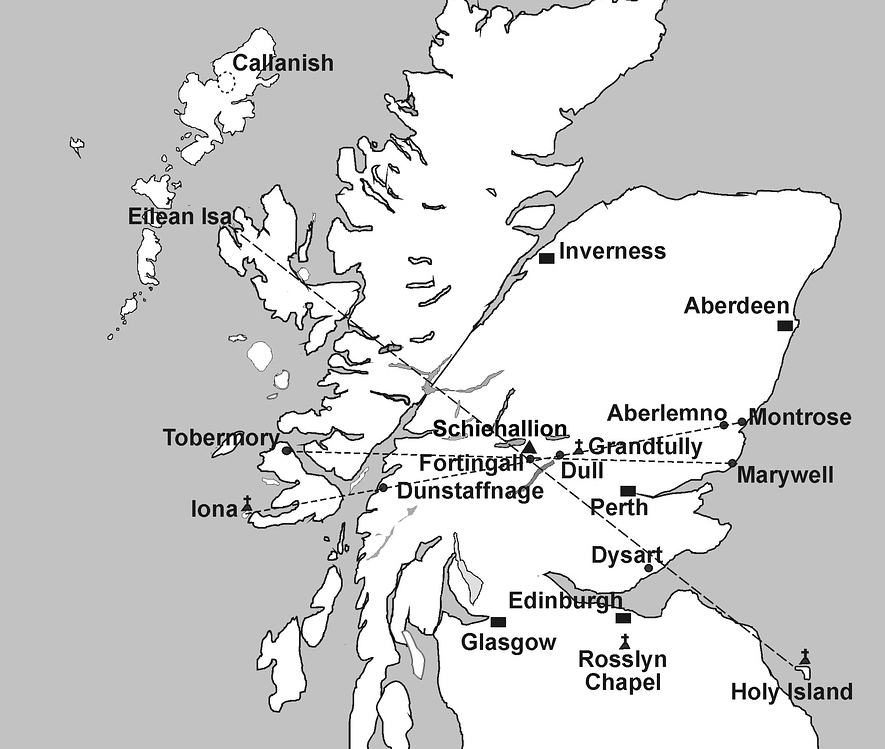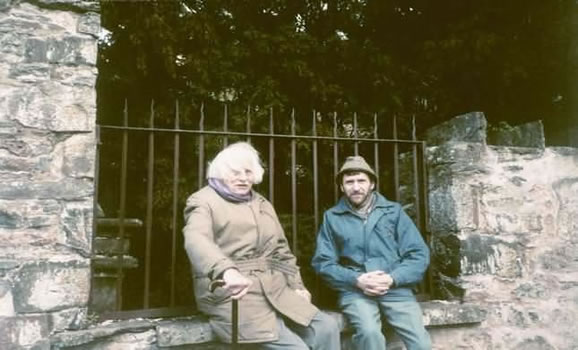|
The sacred yew
in Fortingall, central Scotland, reputedly the oldest tree in Europe
by Barry Dunford

The Fortingall Yew tree
© Copyright Barry Dunford
Located close to the
geographical centre of Celtic Scotland is to be found a remarkable yew
tree which is currently believed to be around 5,000 years of age, thus
dating its origins to about 3,000 B.C. This yew is to be found in
Fortingall, Perthshire, which lies at the entrance or portal to Glen
Lyon, the longest and arguably the most spectacular glen in Scotland.
When the 18th century traveller and naturalist Thomas Pennant (1726 -
1798) visited Fortingall, he reported that the girth of this age old yew
was fifty six and a half feet. One can but wonder what is giving life
force to this extraordinary aged yew tree which can still be seen to be
thriving at the present time, and from whence came the mother yew which
gave birth to this archaic tree sited at Fortingall?
In a land which is
permeated with an ancient Celtic mythos relating to fairy realms and
other worldly devic entities, such an elderly yew tree would have been
highly venerated during the remote ages of past antiquity. Indeed, it
has been said that Beltane fires celebrating the old Mayday festival
were at one time lit at this site. Moreover, this ancient yew may have
been 3,000 years old when, according to a local oral tradition, Pontius
Pilate was born at Fortingall, which translates from the gaelic
placename 'Feart-nan-Gall' as the 'Stronghold of the Strangers'. Nowhere
else in Scotland, or for that matter in the British Isles, has an oral
tradition and association with the birth of Pontius Pilate; so why
should the tiny and obscure hamlet of Fortingall lay claim to this
tradition, unless there is an intrinsic element of truth in what would
otherwise be deemed as an audacious presupposition.
The yew is a primordial
tree and it is believed to date back for at least two hundred million
years, which considerably antedates the era of the human race. It is no
wonder that from time immemorial the eternal yew appears to have been
seen as the immortal tree of life and held with sacred reverence
throuthout the ages. According to ancient lore it would appear that the
yew was seen as an arcane repository, i.e. a tree of knowledge. It has
also been noted that yew trees were often associated with ancient hill
forts and, true to form, on an elevated position close by the Fortingall
Yew is to be found the remains of an old hill fort called Dun Geal which
translates from the gaelic as 'the white fort'. At the time of Christ,
Dun Geal was the residence of the Caledonian King, Metallanus, of whom
local tradition claims Pontius Pilate was a relative.
Commenting on the
Fortingall Yew, Vaughan Cornish, D.Sc., in his book The Churchyard
Yew & Immortality (1946) remarks: "Of Yew trees in the churchyards
of Scotland the most celebrated is that of Fortingall in Perthshire. The
tree as measured in A.D. 1771 by Thomas Pennant was 56 1/2 feet in
circumference and as measured by Daines Barrington in A.D. 1769, 52
feet, thus being greater than that of any churchyard Yew of England or
Wales. This led to the supposition that of all the trees in Britain the
Fortingall Yew was monarch of antiquity. Upon this belief legends grew.
One of these was embodied in a poem by W. Cowan, from which the
following is a quotation:
'Here Druid priests their
altars placed,
And sun and moon adored.
* * * * * * *
A tree - the sacred Yew,
Symbol of immortality -
Beside their altar grew.'
Another legend is of
special interest because it links the Yew with the life of Christ, as
the Thorn of Glastonbury is linked by the legend of Joseph of Arimathea.
Near Fortingall are the remains of a Roman station, where the tradition
is that the father of Pontius Pilate was a Roman legionary, and that
here his son was born, and that the child played under the Yew, which
was already of venerable age."
Aerial photographs of
Fortingall reveal a marking in the landscape which is believed to
indicate the enclosure of an early Christian monastic site.
Interestingly, this monastic settlement appears to have been centered
around the Fortingall Yew tree. Such is the reputation of this
remarkable Yew that in 1993 a sapling from this archaic tree was planted
in Glastonbury Abbey, while concurrently monks from the Tibetan Buddhist
monastery, Samye Ling in Dumfriesshire, Scotland, planted another
sapling on Holy Island, off the coast of Arran, Scotland. More recently
cuttings were taken from the Fortingall Yew to be grown by the Forestry
Commission at Roslin, another historical sacred site in Scotland. These
yew cuttings will eventually be planted around the country at such
places as the arboretum at Scone Palace. Interestingly, Scone was at one
time home to the famous "Stone of Destiny" which was central to the
Coronation ceremony of the old Scottish Kings.
There has been a
traditional association with the mythos of the sacred yew and the
natural philosophy of the Celtic Druid Magi. "Without doubt the yew
stood for sacred mystery in the Druid tradition; yews were planted
systematically about the places, often wells, that held sacred truths,
perhaps to awe votaries as much as because the trees themselves held
sacred properties....In Druid tree language it stood for the Ovate
grade, one who specialized in learning concerning the mysteries." (The
Book of Druidry by Ross Nichols, 1990). In both the Druidic
tradition of reincarnation, and the later Christian doctrine of the
resurrection, the yew was viewed as a natural emblem of everlasting
life.
The 19th century
antiquary, Godfrey Higgins, in his erudite work, The Celtic Druids,
published in 1829, makes the following intriguing observation: "Perhaps
it may be thought far fetched, but, may not the name of the Yew, the
very name of the God Jehovah, have been given it from its supposed
almost eternity of life? It is generally believed to be the longest
lived tree in the world. If this were the case, when a person spoke of
the Yew-tree, it would be nearly the same as to say the Lord's tree."
Moreover, in the Himalayas the yew was sometimes called deodar which
means 'God's Tree'. There has even been a revelatory comment made that
"the Yew is as pure a manifestation of divine consciousness in our
midst, as the presence of a Buddha or Christ is!" (The Tree of
Immortality, The-Tree.org.uk)
There is a tradition that
the Cross of Christ was a yew tree probably because of its symbolism of
immortality. This may explain the following observation: "Although the
Yew was planted on temple sites, and was a survival of cultus
arborum (tree worship) yet, strange to say, it was never damaged,
but was adopted by the Christians as a holy symbol." (The Church Yew
& Immortality by Vaughan Cornish). Furthermore, the yew also figures
in the folklore of the gypsies who believe that the planting of a yew
near one's home provides protection. Interestingly, about a century ago
gypsies were found to be living in the hollow churchyard yew at Leeds in
the english county of Kent.
Legend claims that the
Fortingall Yew marks the actual geographic centre of Scotland and its
heart or 'axis mundi', although it is possible that geographically the
real axis mundi is located on Mt. Schiehallion ("the fairy hill of the
Caledonians"), the holy mountain which lies just five miles north of
Fortingall. However, there may be a connective node between this sacred
yew and the holy mountain to the north of it. In his insightful work
At the Centre of the World (1994), John Michell observes: "Every
Celtic community, tribe and national federation of tribes had its sacred
assembly place of law of justice. These were centrally placed at the
mid-point of their territories....the first thing that was needed by
those who created sacred landscapes was to locate the country's main
axis, the preferably north-south line between its two extremities,
passing through the centre. It corresponded to the world-tree, the
shaman's pole by which he ascends to the world of spirits, and all other
symbols of the universal axis....Guarding and overlooking the omphalos,
generally to the north of it in the direction from which disruptive
forces are traditionally supposed to emanate, is found a lone, conical
mountain. Its mythological prototype is the mountain at the centre of
the world. The chief god of the pantheon resides there, presiding
awesomly over the rituals in his sanctuary below." It is interesting to
note that the geographical relationship between the conical Mt.
Schiehallion and the Fortingall Yew tree correlates exactly to this
ancient mythos as described by John Michell.

Mount Schiehallion ("The
fairy hill of the Caledonians")
Following on from this,
Geoffrey Ashe in his work The Ancient Secret (1979) relates that
the shaman climbs a pole or tree into the celestial realms: "The main
feature of the shaman's universe is the cosmic centre, a bond or axis
connecting earth, heaven and hell. It is often pictured as a tree or a
pole holding up the sky. In a trance state, a shaman can travel
disembodied from one region to another, climbing the tree into the
heavens or following its downward extension. By doing so he can meet and
consult the gods." Commenting on this observation, Dr. Gordon Strachan
says: "The pole, axis or tree is in fact the axle of the cosmos which we
encountered in our discussion about the holy mountains such as Meru,
Olympus, Alborg and Aralu, of which Mount Zion and indeed Mount Sinai
were also examples. These, we established, were linked to a prototype in
the north which may well have been connected with Stonehenge or other
megalithic sites, but which was ultimately identifiable as the celestial
North Pole. This now appears to be the same pole, or axis mundi
up which the shaman climbed or rather flew in his astral body, to the
council of the gods....the implication is that Ezekiel, Daniel, Enoch
and Moses on Sinai, not only had shamanic, out-of-body experiences of
the ascent to the divine presence, but also that this was via the
axis mundi up to the celestial pole, past the phantasmagoria of the
northern lights and through the hole in the apex of the vault of heaven
which St. John in Revelation calls an 'open door'. (Rev. 4:1)". (Jesus
the Master Builder: Druid Mysteries and the Dawn of Christianity,
1998).
In this same work Gordon
Strachan goes on to say: "The unmistakable implication is also that
Jesus was himself the supreme initiate of this experience." In the light
of the foregoing one might speculate as to whether Jesus visited the
Fortingall Yew during his "lost years" which have gone unrecorded in the
Canonical Gospels. Other research by this writer suggests that Jesus may
indeed have visited ancient Alban, i.e. the Scottish Highlands and
Islands.
It has been noted that
"Yew were also often planted at the centre of a tribal territory, which
often served as a gathering place for clan meetings. The Fortingall Yew
is one such example." (The Tree of Immortality, The-Tree.org.uk).
Furthermore, John Michell comments: "The powers of ancient kings,
chiefs, priests and law-givers were not of human origin but were derived
and borrowed from the symbolic centre. This was also regarded as the
birthplace of the tribe, so it belonged to the people as a whole rather
than to any ruler they might elect. Once chosen, the king was irradiated
with the mystical power of the centre and became the agent and
interpreter of its influence. Installed upon the local world-centre
rock, at the point of mediation between the law of heaven and the will
of the people, he surveyed the cosmologically ordered divisions of his
realm. Its ritual boundaries, defining the spiritual, astrological
limits of each section, may have been marked by the straight alignments
of stone pillars which converge upon Boscawen-un and other stone
circles." (At the Centre of the World)
It is known that the yew
was often used as a landmark. Writing about straight tracks or ley lines
on the landscape, Alfred Watkins in his classic work The Old Straight
Track (1925) makes an interesting observation: "There is every
reason to surmise that trees were planted in prehistoric times as
sighting marks....trees are joined with stones, water [wells],
mountain-tops, mounds, and fire as objects of ancient reverence and even
worship; all these are found as sighting points on the ley." Notably, a
number of telluric ley lines or earth energy currents have been dowsed
as passing through Fortingall, thus indicating that a major earth energy
vortex may be located here. Could this be another factor in accounting
for the specific placement and perhaps longevity of what is reputed to
be the oldest tree in Europe?

Map of Scotland showing three ley
lines and some of the ancient sites
which they traverse. 1. Between the Holy Isle of Iona and Montrose
(Mount
of the Rose); 2. Between Tobermory (Well of Mary) and Marywell; 3.
Between Eilean Isa (Island of Jesus) and Holy Island (Lindisfarne). Note
that all three leylines intersect at the central nodal point of
Fortingall.
© copyright Barry Dunford, extracted from "The
Holy Land of Scotland"
Finally, to quote Sir
George Trevelyan: "What magic is there in the ancient yew trees! What is
it in them that fires our vision and fills the soul with mystery,
touching ageless history? We associate our yew trees with our
churchyards....The great yew trees can be 2,000 years old, or 3,000, or,
in some cases, they may reach 4,000 years or more, and our churches were
mostly built less than 1,000 years ago. The yews came first, planted on
sacred sites known to the Druids. The later church builders were
sensitive to the holy places and knew where to build their churches. So
let us awaken to the wonder of the yews, planted long before the
churches were built, and linked with ancient pre-Christian ritual and
mystery." (The Sacred Yew by Anand Chetan and Diana Brueton,
1994).

The writer with
Sir George Trevelyan at the Fortingall Yew in May 1994.
Six months earlier,
Sir George planted a sapling from this yew tree in Glastonbury Abbey
, England. At the
same time monks from the Tibetan Buddhist monastery, Samye Ling,
Scotland, planted another sapling from this same yew, on Holy Island off
the coast of Arran, Scotland.
© copyright Barry Dunford
© Copyright 2004 Barry
Dunford. All rights reserved. PERMISSION FOR
USE: No part of this article may be published without the
permission of the author Barry Dunford |
